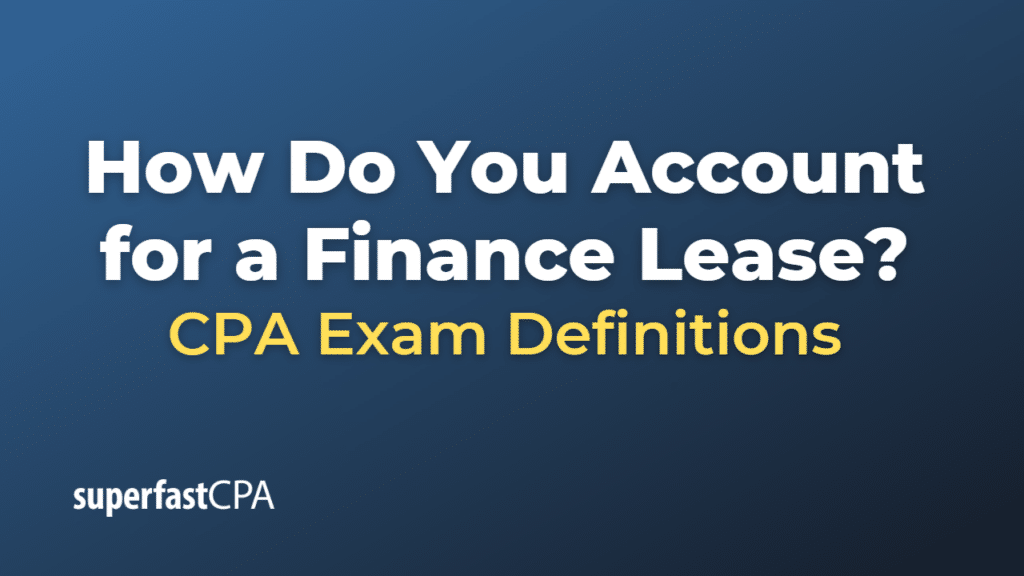How to Account for a Finance Lease
A finance lease (also known as a capital lease in some regions) is a type of lease where the risks and rewards of ownership are substantially transferred from the lessor to the lessee. This means that, although the lessor technically owns the asset, the lessee effectively gets most of the benefits and drawbacks of ownership.
From an accounting perspective, both lessees and lessors must account for finance leases differently.
For Lessees (the party that uses the asset):
Under most accounting standards, including International Financial Reporting Standards (IFRS) and US Generally Accepted Accounting Principles (GAAP), lessees are required to “capitalize” a finance lease, meaning they must record it as an asset and a liability on their balance sheet.
Here are the steps for lessees:
- Recognition: At the inception of the lease, the lessee records the leased asset as a fixed asset and the present value of the future lease payments as a liability on the balance sheet. The asset and liability are typically both recorded at the lower of the fair value of the asset and the present value of the minimum lease payments.
- Depreciation: Each period, the lessee depreciates the leased asset over the shorter of its useful life and the lease term. The method of depreciation will depend on the company’s accounting policies.
- Interest Expense: Each period, the lessee also records an interest expense on the outstanding lease liability. This interest is calculated by multiplying the lease liability by the interest rate implicit in the lease.
- Lease Payments: When the lessee makes a lease payment, it is split between reducing the lease liability and the interest expense.
For Lessors (the party that owns the asset):
Lessors also record finance leases differently from operating leases. When the lease is a finance lease:
- Recognition: The lessor derecognizes the asset from its balance sheet and recognizes a receivable equal to the net investment in the lease.
- Interest Income: Over time, the lessor recognizes interest income based on the lease’s implicit interest rate.
- Lease Payments: When the lessor receives a lease payment, it is split between reducing the lease receivable and the interest income.
Please note that these are general procedures and might vary depending on the specific accounting standards followed in a given jurisdiction. Also, the determination of whether a lease is a finance lease or an operating lease is based on specific criteria set out in the relevant accounting standards.
Example of How to Account for a Finance Lease
Let’s assume a company, TechCo, enters into a finance lease agreement for a piece of equipment. The cost of the equipment is $50,000, the implicit interest rate in the lease is 6%, and the lease term is 5 years with annual payments made at the end of each year.
For the Lessee (TechCo)
At the inception of the lease, TechCo would record the asset and the lease liability on its balance sheet at the present value of the lease payments. If we assume that the lease requires equal annual payments over its term, we can calculate the present value using the formula for the present value of an ordinary annuity. In this case, the present value of the lease payments would be $50,000.
The journal entries would be as follows:
At the inception of the lease:
- Debit Equipment (Asset) $50,000
- Credit Lease Liability $50,000
Each year, TechCo would then recognize an interest expense and reduce the lease liability by the amount of the lease payment minus the interest expense.
For example, in the first year, the interest expense would be $3,000 (6% of $50,000), and the lease payment would be determined by the lease agreement. Let’s assume it’s $11,000. The lease liability reduction would be $8,000 ($11,000 – $3,000). TechCo would also record depreciation on the equipment.
At the end of the first year:
- Debit Interest Expense $3,000
- Debit Lease Liability $8,000
- Credit Cash $11,000
- Debit Depreciation Expense (amount depends on the chosen depreciation method)
- Credit Accumulated Depreciation (same amount as the Depreciation Expense)
For the Lessor
At the inception of the lease, the lessor would record a lease receivable and remove the equipment from its balance sheet.
At the inception of the lease:
- Debit Lease Receivable $50,000
- Credit Equipment $50,000
Each year, the lessor would then recognize lease income and reduce the lease receivable by the amount of the lease payment minus the lease income.
For example, in the first year, the lease income would be $3,000 (6% of $50,000), and the lease payment would be the same $11,000. The lease receivable reduction would be $8,000 ($11,000 – $3,000).
At the end of the first year:
- Debit Cash $11,000
- Credit Lease Receivable $8,000
- Credit Interest Income $3,000
Please note that this is a simplified example, and actual lease agreements may include more complex terms and conditions. The exact accounting treatment may also vary depending on the specific accounting standards in place.













